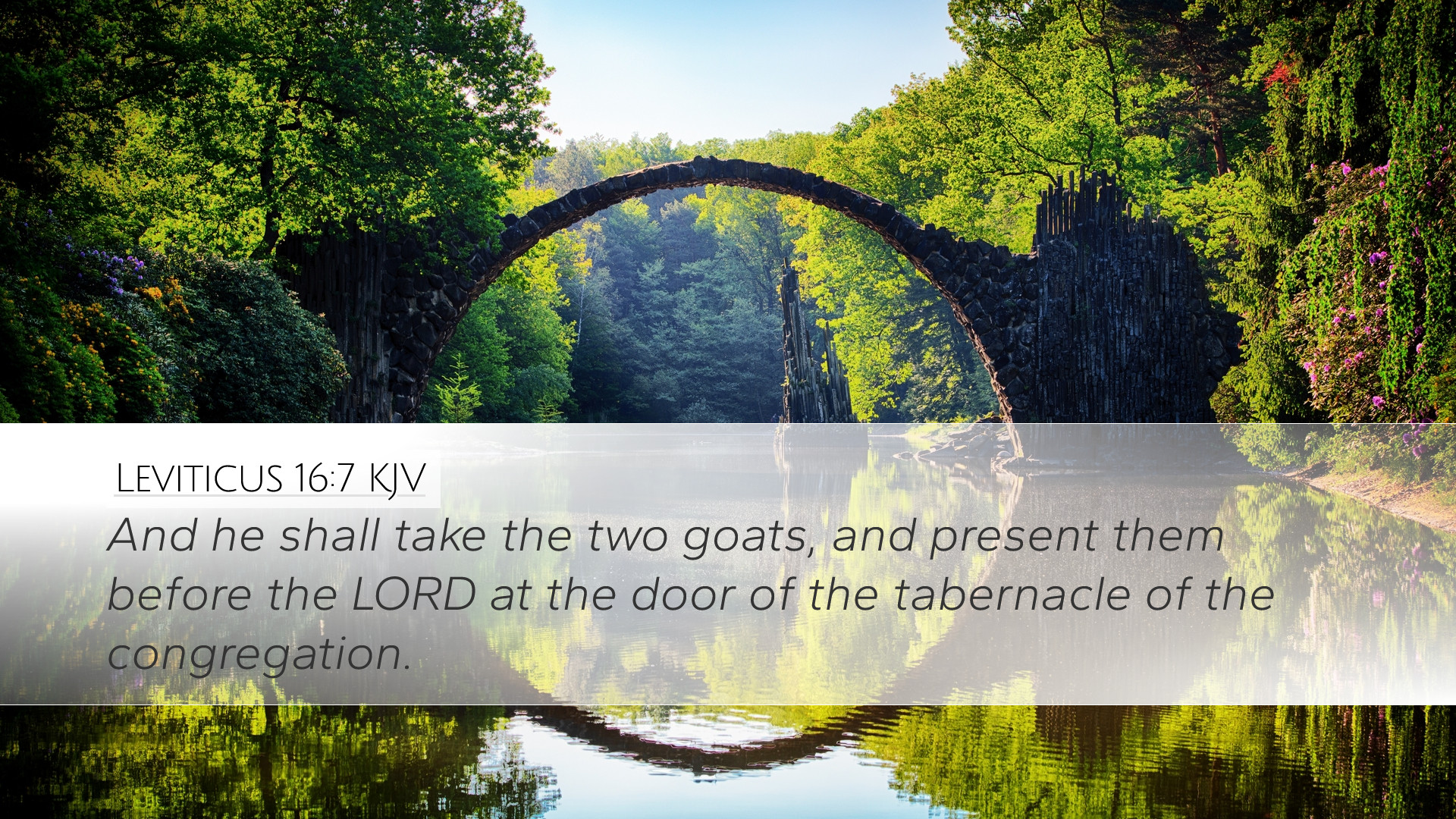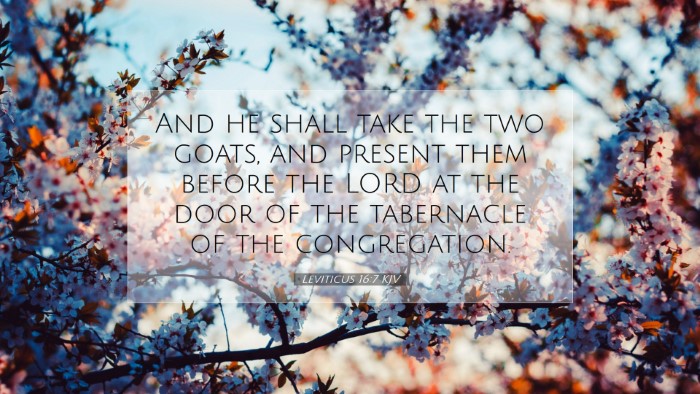Commentary on Leviticus 16:7
Leviticus 16:7 states, “And he shall take the two goats, and present them before the Lord at the door of the tabernacle of the congregation.” This verse is a pivotal moment in the Day of Atonement rituals, where the deeper theological implications of sacrifice and redemption are unveiled. The significance of the two goats offers rich insights into God's redemptive plan and the foreshadowing of Christ's atoning work.
Overview of the Context
This chapter outlines the procedures for the Day of Atonement, a vital observance in the Jewish calendar. Matthew Henry notes that the imagery used here is replete with typological understanding. He suggests that the two goats represent the dual aspects of Christ's atonement: the sacrificial lamb and the scapegoat.
The Symbolism of the Goats
The use of two goats is significant. Each goat fulfills a distinct role in the atonement process:
- The Sacrificial Goat: One goat is offered as a sin offering for the people, symbolizing the necessity of bloodshed for atonement (Hebrews 9:22). Albert Barnes emphasizes that this act prefigures Christ's ultimate sacrifice, where His blood would seal the New Covenant.
- The Scapegoat: The other goat, referred to as the scapegoat, is sent into the wilderness, symbolizing the removal of sin from the community. Adam Clarke highlights this as a profound illustration of transference, where sin is laid upon the goat and sent away, representing God's forgiveness and the total elimination of sin’s power.
Theological Implications
The actions described in Leviticus 16:7 resonate deeply with the Christian understanding of redemption. Matthew Henry writes, “The transaction of the two goats signifies the full scope of deliverance from sin.” This underscores that through Christ, believers are not only forgiven but also liberated from the guilt and burden of sin.
Christ as the Fulfillment
In Christian theology, the two goats serve as types pointing directly to Christ's atoning work. The sacrificial goat points to Jesus, who was sent to bear the sin of humanity, fulfilling Isaiah 53:6. Albert Barnes notes, “Christ is the Lamb of God that takes away the sin of the world.”
Conversely, the scapegoat signifies the expulsion of sin. As stated in 1 John 1:7, “the blood of Jesus Christ His Son cleanseth us from all sin.” The act of sending the scapegoat away signifies not only forgiveness but also the assurance that sins are remembered no more (Hebrews 10:17).
The Role of the Priest
The verse also emphasizes the role of the high priest in this sacrifice. The act of presenting the goats before the Lord indicates a moment of solemnity and divine appointment. Adam Clarke points out that it reinforces the idea of mediation; only through the priest could the people access God. In this role, the priest represents Christ, our ultimate High Priest, who intercedes on behalf of humanity (Hebrews 4:14).
The Importance of Community Atonement
Leviticus 16:7 occurs within the context of community. It serves as a reminder that individual sin impacts the entire community. Matthew Henry highlights this communal aspect, asserting that atonement is not just a personal affair but a corporate one. Pastors and theologians alike should recognize the impact of collective sin and the necessity of corporate confession and repentance within the body of Christ.
Practical Applications for Ministry
The insights from this verse and its surrounding context hold practical significance for pastoral ministry:
- Encouragement of Confession: Encourage congregants to confess their sins, understanding that true repentance leads to freedom, just as the scapegoat was removed from the camp.
- Teaching on Sacrifice: Utilize the imagery of the sacrificial goat to expound upon the vastness of Christ's love and sacrifice, fostering gratitude and commitment amongst believers.
- Community Acknowledgment: Promote the importance of communal worship and atonement, fostering a culture where individuals support one another in their spiritual journeys.
Conclusion
Leviticus 16:7 encapsulates profound theological truths about atonement, sacrifice, and community. The two goats illustrate the completeness of Christ’s work, fulfilling both the necessity of payment for sin and the assurance of guilt removal. As we reflect on this passage, may we appreciate our position in Christ and the profound grace given to us, encouraging us to live in light of His redemptive work.


